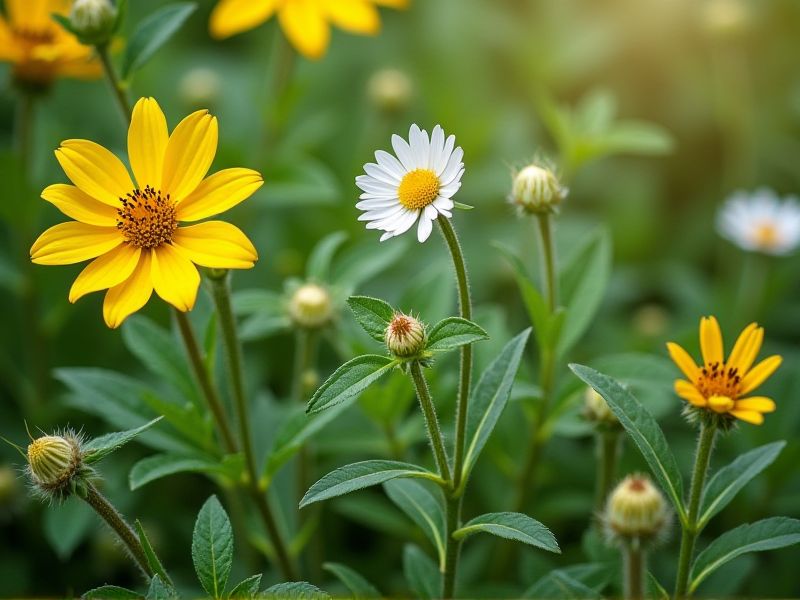
Fast-growing plants such as bamboo, sunflowers, and certain types of vining plants are ideal for rapidly occupying available space in gardens or landscapes. Bamboo can reach impressive heights within months, providing both privacy and aesthetic appeal. Sunflowers not only grow quickly but also create vibrant, cheerful displays, attracting pollinators like bees and butterflies. Vining plants, such as sweet peas or morning glories, can cover trellises, fences, or walls in no time, adding dimension to your outdoor spaces. These options are perfect for gardeners seeking immediate visual impact and lush greenery.
List of some Fast-growing plants that fill space quickly
- Bamboo (Bambusoideae)
- Sunflower (Helianthus annuus)
- Nasturtium (Tropaeolum majus)
- Pumpkin (Cucurbita pepo)
- Sweet Alyssum (Lobularia maritima)
- Zinnia (Zinnia elegans)
- Morning Glory (Ipomoea tricolor)
- Marigold (Tagetes spp.)
- Black-Eyed Susan (Rudbeckia hirta)
- Sweet Pea (Lathyrus odoratus)
Important things about Fast-growing plants that fill space quickly
Growth Rate
Fast-growing plants, such as bamboo and annual sunflowers, can dramatically fill space in your garden within a short time frame. Bamboo species, particularly Phyllostachys aureosulcata, can reach heights of up to 40 feet in just a few growing seasons, making them excellent privacy screens. Meanwhile, annual sunflowers (Helianthus annuus) can germinate quickly and bloom in as little as 70 days, providing vibrant color and attracting pollinators to your landscape. Incorporating these plants not only enhances the visual appeal of your space but also aids in soil stabilization and garden biodiversity.
Soil Requirements
Fast-growing plants that fill space quickly require well-draining, nutrient-rich soil to thrive. Ideal soil pH for most of these species ranges between 6.0 and 7.5, promoting optimal nutrient absorption. Incorporating organic matter like compost can enhance soil structure and fertility, supporting vigorous growth. When selecting plants, consider those that tolerate various soil types, as this adaptability can ensure robust coverage in diverse landscapes.
Sunlight Needs
Fast-growing plants that thrive in full sun can transform your garden into a vibrant space quickly. Species like sunflower (Helianthus annuus) and zinnias (Zinnia elegans) not only add bursts of color but also reach impressive heights within weeks. If you're looking for ground coverage, consider planting clover (Trifolium repens) for its rapid spread and nitrogen-fixing ability, enriching your soil in the process. With the right selection, your outdoor area can become a lush retreat, providing beauty and biodiversity without the long wait.
Watering Frequency
Fast-growing plants that fill space quickly, such as Bamboo and Sunflower, require consistent watering to thrive and maintain their rapid growth rate. You should ideally water these plants deeply once a week, ensuring the soil stays moist but not waterlogged. During particularly hot or dry spells, consider increasing the frequency to every few days to prevent stress and promote healthy foliage. Monitoring soil moisture levels will help you adjust your watering schedule effectively, optimizing growth and overall plant health.
Fertilization Schedule
Fast-growing plants like sunflowers, zinnias, and marigolds require a strategic fertilization schedule to thrive and fill space quickly in your garden. Applying a balanced fertilizer high in nitrogen every four to six weeks during the growing season can significantly enhance their growth rates. Incorporating organic options such as compost or well-rotted manure not only enriches the soil but also promotes healthy root development. Regular watering, combined with this fertilization routine, ensures that your selected fast-growing varieties achieve their full potential in your landscape.
Pest Resistance
Fast-growing plants, such as sunflowers and zinnias, not only fill space quickly but often exhibit remarkable pest resistance. Sunflowers, with their towering height and tough leaves, naturally deter insects like aphids due to their unique oils and sticky sap. Zinnias, known for vibrant blooms, attract beneficial pollinators while being resilient against pests like spider mites and whiteflies. By incorporating these plants into your garden, you create a beautiful and thriving ecosystem that minimizes the need for chemical pesticides.
Pruning Techniques
Pruning techniques for fast-growing plants are essential to maintain their shape, health, and overall growth rate. Regular pruning encourages bushier growth in species like willows or boxwoods, which are known for rapid expansion. By removing dead or overgrown branches, you not only improve air circulation but also stimulate new growth, enhancing the plant's vitality. Implementing strategic cuts helps you manage these plants effectively, ensuring they fill space aesthetically without overwhelming surrounding areas.
Seasonal Changes
Fast-growing plants such as sunflower (Helianthus annuus) and zinnias (Zinnia elegans) are perfect choices for creating vibrant, filled spaces in your garden during spring and summer. These annuals thrive in well-drained soil and require full sunlight, making them ideal for quickly enhancing the visual appeal of your outdoor area. In addition to their aesthetic benefits, plants like sweet peas (Lathyrus odoratus) and nasturtiums (Tropaeolum majus) are not only beautiful but also attract pollinators, contributing to a healthier ecosystem. By selecting these seasonal beauties, you can enjoy a lush landscape that changes dynamically throughout the warmer months.
Invasive Potential
Fast-growing plants, such as Japanese knotweed and purple loosestrife, can exhibit invasive potential by rapidly colonizing and outcompeting native species for resources. These plants thrive in various environments, often forming dense thickets that disrupt local ecosystems and hinder biodiversity. In urban and rural settings, their ability to fill spaces quickly can lead to significant management challenges and increased costs for landowners. To protect your garden or landscape, it's essential to identify and control these invasive species before they establish themselves.
Ideal Companion Plants
Fast-growing plants are excellent choices for filling space in your garden or landscape quickly, providing both beauty and functionality. Consider using Sunflower (Helianthus annuus) for its vibrant blooms and ability to attract pollinators, or Zinnia, known for its diverse colors and resilience in sunny spots. If you prefer foliage, the fast-growing Japanese Knotweed (Fallopia japonica) offers lush greenery but should be managed carefully due to its invasive nature. Incorporating these rapid growers can create an instant visual impact while promoting a thriving ecosystem in your outdoor space.
